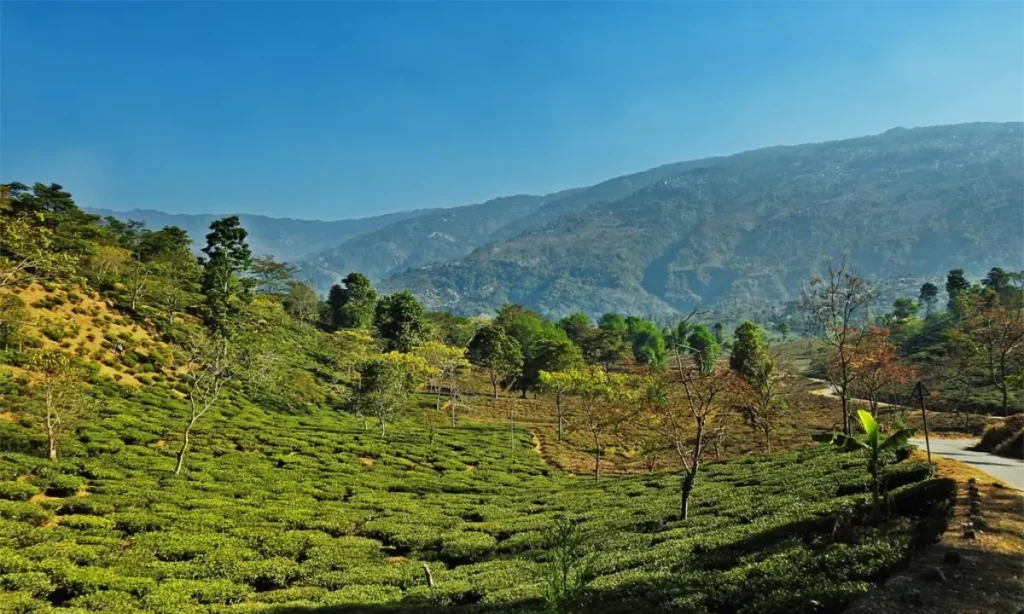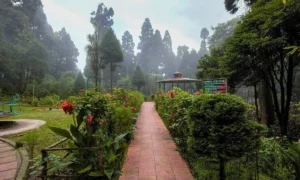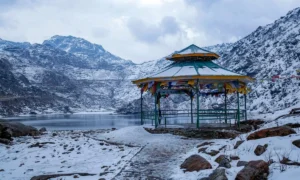Are you dreaming of misty mornings, lush green tea gardens, and the scent of fresh tea leaves in the air? If so, you are not alone. Many travelers wonder how to experience the tranquility and beauty of a working tea plantation in India. Perhaps you have heard whispers about the famous Darjeeling tea and are curious about where it is grown. Well, you are in luck. This guide is your perfect companion for a journey to the stunning Ambootia Tea Estate, Kurseong.
Nestled in the breathtaking hills of Kurseong, the Ambootia (Ambotia) Tea Estate offers more than just scenic views; it provides a deep dive into the world of organic tea production. It is a place where nature, sustainability, and history blend together perfectly. Whether you are a tea aficionado, a nature lover, or simply looking for a peaceful escape from city life, this article will walk you through everything you need to know. You will discover the best time to visit, what activities await you, and how to make the most of your trip to this incredible location. Get ready to feel like a true insider as we explore the magic of this tea garden.
Exploring the Heart of Organic Tea: Ambootia Tea Garden, Kurseong

The Ambootia Tea Estate Kurseong is a jewel in the crown of Darjeeling tea production. It is renowned for its commitment to organic and biodynamic farming, a practice that sets it apart from many other estates. Established in 1860, this historical estate has been a pioneer in sustainable agriculture, focusing on methods that enrich the soil and produce high-quality tea without the use of chemical fertilizers or pesticides. The estate has received numerous accolades for its teas, which are celebrated globally for their unique flavor profile and aroma.
A Glimpse into the Past: History and Heritage Ambootia Tea Garden Kurseong
The journey of the Ambootia Tea Estate began over 160 years ago. Its founders recognized the ideal climate and fertile soil of the Kurseong region for growing the delicate Camellia sinensis plant. Over the decades, the estate has evolved, but its core philosophy of respecting nature has remained steadfast. The name “Ambootia” itself is said to be derived from the local language, meaning “place of mango trees,” although tea plants now dominate the landscape. The estate’s commitment to biodynamic farming is a testament to its forward-thinking approach. According to the Biodynamic Association of India, this method treats the farm as a single, self-sustaining organism, promoting a holistic and healthy ecosystem.
What to See and Do at Ambootia Tea Garden Kurseong
A visit to the estate is an experience for all the senses. Here is a breakdown of the key activities and sights you can enjoy:
- Tea Factory Tour: This is a must-do for any visitor. You will get to witness the entire process of tea production, from the plucking of the leaves to the final packaging. Guides explain the intricate steps involved, including withering, rolling, oxidation, and drying. This firsthand look provides a new appreciation for the effort that goes into every cup of tea.
- Strolling Through the Gardens: The rolling hills and manicured tea bushes provide a picturesque setting for a leisurely walk. The fresh, crisp mountain air is invigorating, and the panoramic views of the surrounding valleys are simply stunning. It is the perfect opportunity for some photography or simply quiet contemplation.
- Tea Tasting Session: After seeing how the tea is made, you will be invited to a tasting session. This is where you can sample various teas produced at the estate, including Darjeeling First Flush, Second Flush, and Autumnal Flush varieties. Experts will teach you how to identify different flavors and aromas, helping you become a more discerning tea drinker.
- Staying at the Heritage Bungalow: For a truly immersive experience, you can stay at the estate’s historic bungalow. These accommodations offer a step back in time, with vintage decor and warm hospitality. Waking up to the sounds of nature and the sight of the tea gardens right outside your window is an unforgettable experience.
Best Time to Visit and Weather at Ambootia Tea Garden Kurseong
The weather in Kurseong is generally pleasant, but timing your visit can greatly enhance your experience. The best time to visit the Ambootia Tea Estate Kurseong, is during the spring (March to May) and autumn (September to November).
Spring (March to May) Ambootia Tea Garden, Kurseong
This is the peak season for a reason. The weather is comfortably cool, with temperatures ranging from 10°C to 20°C. The skies are generally clear, offering breathtaking views of the surrounding mountains and valleys. This is also the time of the First Flush, when the new tea leaves are picked, making the tea production process particularly active and fascinating to observe.
Monsoon (June to September) Ambootia Tea Garden, Kurseong
While the rain makes the tea gardens even more vibrant and lush, heavy downpours can lead to landslides and make travel difficult. The area receives significant rainfall during these months. If you do not mind the rain and enjoy a misty, serene atmosphere, this can be a beautiful but challenging time to visit.
Autumn (September to November) Ambootia Tea Garden, Kurseong
As the monsoon rains subside, the landscape is refreshed and revitalized. The air is crisp, the views are clear, and the temperatures are cool and pleasant. This season offers a wonderful balance of good weather and active tea production, with the Second Flush and Autumnal Flush harvests taking place.
Winter (December to February) Ambootia Tea Garden, Kurseong
It can get quite cold during the winter months, with temperatures dropping to as low as 2°C. While the tea gardens are less active during this time, the clear skies can provide stunning views of snow-capped peaks in the distance, and the town is much less crowded. Be sure to pack heavy woolens if you plan a winter trip.
The Kurseong Connection: More Than Just Tea
While the Ambootia Tea Estate is a major draw, Kurseong itself is a charming hill station with much to offer. Known as the “Land of the White Orchids,” Kurseong is less crowded than its famous neighbor, Darjeeling, but equally beautiful. Visitors can explore local markets, take a ride on the Darjeeling Himalayan Railway, or visit viewpoints like Eagle’s Crag, which offers spectacular sunrise and sunset views. The pleasant climate and tranquil atmosphere make it an ideal place to relax and recharge. It is advisable to book accommodations and tours in advance, especially during peak tourist seasons, as the heritage bungalows are limited. The estate is accessible by road from Siliguri or Darjeeling, and the drive itself is a scenic journey through winding mountain roads.
Kurseong Attractions: Distances from the Ambootia Tea Garden, Kurseong
| Destination | Approximate Distance from Museum | Approximate Travel Time |
| Eagle’s Crag (E.C) | 7 km | 23 minutes (by car) |
| Giddapahar View Point | 10.4 km | 33 minutes (by car) |
| Dow Hill Eco Park (Deer Park) | 13.1 km | 42 minutes (by car) |
| Netaji Subhash Chandra Bose Museum | 10.6 km | 34 minutes (by car) |
| Giddapahar Seti Mata Mandir | 9.9 km | 32 minutes (by car) |
| Makaibari Tea Estate | 6 km | 20 minutes (by car) |
| British-era Churches and Schools | 11.2 km | 37 minutes (by car) |
| Bhangzang Salamander Lake | 23 km | 1 hr 1 minutes (by car) |
| Ambotia Shiva Mandir Kurseong | 1.8 km | 6 minutes (by car) |
| Forest Museum, Dowhill | 11.7 km | 40 minutes (by car) |
| Castleton and other gardens | 5.4 km | 18 minutes (by car) |
Frequently Asked Questions Ambootia Tea Garden Kurseong
1. Is Ambootia Tea Estate a good place to visit for families?
Yes, it is a wonderful place for families. The peaceful environment and various activities, such as nature walks and factory tours, can be educational and enjoyable for all ages.
2. How long does a typical visit to the tea estate last?
A standard visit, including a factory tour and tea tasting, can take approximately two to three hours. If you wish to stay longer or explore the surrounding areas, you should plan for a full day or an overnight stay.
3. Do I need to book my visit in advance?
It is highly recommended to book your visit in advance, especially if you plan to take a guided tour or stay at the heritage bungalows. This ensures availability and a smooth experience.
4. What is the difference between organic and regular tea?
Organic tea is grown without the use of synthetic pesticides, herbicides, or fertilizers. Ambootia’s biodynamic farming methods go a step further by creating a self-sustaining ecosystem that promotes natural health and vitality in the soil and plants.
Conclusion
A visit to the Ambootia Tea Estate Kurseong is more than just a sightseeing trip; it is an immersive experience that connects you with nature, history, and the art of tea making. From witnessing the journey of a tea leaf from the bush to the cup to simply breathing in the fresh mountain air, you will leave feeling refreshed and enlightened. This guide has provided you with the insights needed to plan a memorable journey.
We hope you will be inspired to explore this enchanting corner of the world. What are you most excited to see or do at the Ambootia Tea Estate? Share your thoughts and questions in the comments below.



